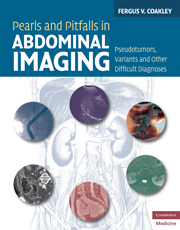Book contents
- Frontmatter
- Contents
- Preface
- Acknowledgements
- Section 1 Diaphragm and adjacent structures
- Section 2 Liver
- Section 3 Biliary system
- Section 4 Spleen
- Section 5 Pancreas
- Section 6 Adrenal glands
- Section 7 Kidneys
- Section 8 Retroperitoneum
- Section 9 Gastrointestinal tract
- Case 54 Gastric antral wall thickening
- Case 55 Pseudoabscess due to excluded stomach after gastric bypass
- Case 56 Strangulated bowel obstruction
- Case 57 Transient ischemia of the bowel
- Case 58 Angioedema of the bowel
- Case 59 Small bowel intramural hemorrhage
- Case 60 Pseudopneumatosis
- Case 61 Meckel's diverticulitis
- Case 62 Small bowel intussusception
- Case 63 Pseudoappendicitis
- Case 64 Portal hypertensive colonic wall thickening
- Case 65 Pseudotumor due to undistended bowel
- Case 66 Gastrointestinal pseudolesions due to oral contrast mixing artifact
- Case 67 Perforated colon cancer mimicking diverticulitis
- Section 10 Peritoneal cavity
- Section 11 Ovaries
- Section 12 Uterus and vagina
- Section 13 Bladder
- Section 14 Pelvic soft tissues
- Section 15 Groin
- Section 16 Bone
- Index
- References
Case 64 - Portal hypertensive colonic wall thickening
from Section 9 - Gastrointestinal tract
Published online by Cambridge University Press: 05 November 2011
- Frontmatter
- Contents
- Preface
- Acknowledgements
- Section 1 Diaphragm and adjacent structures
- Section 2 Liver
- Section 3 Biliary system
- Section 4 Spleen
- Section 5 Pancreas
- Section 6 Adrenal glands
- Section 7 Kidneys
- Section 8 Retroperitoneum
- Section 9 Gastrointestinal tract
- Case 54 Gastric antral wall thickening
- Case 55 Pseudoabscess due to excluded stomach after gastric bypass
- Case 56 Strangulated bowel obstruction
- Case 57 Transient ischemia of the bowel
- Case 58 Angioedema of the bowel
- Case 59 Small bowel intramural hemorrhage
- Case 60 Pseudopneumatosis
- Case 61 Meckel's diverticulitis
- Case 62 Small bowel intussusception
- Case 63 Pseudoappendicitis
- Case 64 Portal hypertensive colonic wall thickening
- Case 65 Pseudotumor due to undistended bowel
- Case 66 Gastrointestinal pseudolesions due to oral contrast mixing artifact
- Case 67 Perforated colon cancer mimicking diverticulitis
- Section 10 Peritoneal cavity
- Section 11 Ovaries
- Section 12 Uterus and vagina
- Section 13 Bladder
- Section 14 Pelvic soft tissues
- Section 15 Groin
- Section 16 Bone
- Index
- References
Summary
Imaging description
Colonic wall thickening (often defined as a colonic wall thickness greater than 6 mm, although most radiologists use expert judgment to make this diagnosis in practice) is a common finding in patients with cirrhosis and portal hypertension, and appears to reflect the congestive effect of elevated portal venous pressure (Figures 64.1 and 64.2) [1, 2]. While any or all of the large bowel may be affected, the right colon is frequently the only or dominant site of involvement [1]. It has been postulated that such preferential involvement of the right colon reflects drainage of the left colon through the inferior mesenteric vein to the splenic vein, with relative decompression through short gastric, lienorenal, or gastroesophageal venous collaterals [1]. The condition is variable and, for example, can occur in non-cirrhotic portal hypertension or affect the left colon disproportionately (Figure 64.3).
Importance
Colonic wall thickening in cirrhosis should not be mistaken for colitis or colon cancer, since this may provoke unnecessary investigation and patient anxiety. Portal hypertensive colonic wall thickening is correlated with the degree of cirrhosis and portal hypertension [3].
Typical clinical scenario
The reported frequency of colonic wall thickening in cirrhotic patients varies between 33% (21 of 63) and 37% (21 of 57) [1, 2]. As such, it is common to see colonic wall thickening as an incidental finding in cirrhotic patients.
Information
- Type
- Chapter
- Information
- Pearls and Pitfalls in Abdominal ImagingPseudotumors, Variants and Other Difficult Diagnoses, pp. 216 - 219Publisher: Cambridge University PressPrint publication year: 2010
References
Accessibility standard: Unknown
Why this information is here
This section outlines the accessibility features of this content - including support for screen readers, full keyboard navigation and high-contrast display options. This may not be relevant for you.Accessibility Information
- 2
- Cited by
